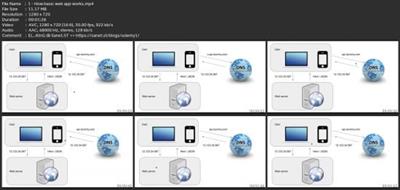System Design Building Blocks
Published 3/2023
MP4 | Video: h264, 1280x720 | Audio: AAC, 44.1 KHz
Language: English | Size: 1.17 GB | Duration: 3h 48m
Get ready for System Design Interviews by mastering the fundamental concepts for building scalable web systems
What you'll learn
Understand the fundamental principles of system design and their role in building scalable web applications.
Develop expertise in key system components, including databases, load balancers, and caching.
Learn how to apply scaling techniques, such as sharding, replication, and load balancing, to improve web application performance.
Understand the CAP theorem and its implications for system design, and how to design systems that are consistent, available, and partition tolerant.
Master techniques for designing rate limiters, unique ID generators, and other key system components.
Prepare for system design interviews and other technical assessments by mastering foundational system design concepts and techniques.
Stay up-to-date with the latest trends and advancements in web system design.
Requirements
Basic understanding of system architecture: You should have a basic understanding of system architecture and how components interact with each other in a web application.
computer networks and protocols such as TCP/IP, HTTP, and DNS. Familiarity with databases: Students should be familiar with databases and have a basic understanding of relational database concepts such as tables, rows, and columns.
amiliarity with cloud technologies: Students should have a basic understanding of cloud technologies such as Amazon Web Services (AWS) or Microsoft Azure.
Willingness to learn: The course covers a lot of material, and students should be willing to put in the time and effort to learn and practice the concepts covered in the course.
Description
This course is designed to provide a comprehensive understanding of the key building blocks of system design. The course will cover various topics such as basic web architecture, database design, replication, sharding, load balancing, caching, CAP theorem, back-end estimation, message queues, consistent hashing, key-value store, template to approach system design interviews, rate limiter, and unique ID generator.The course will begin with an introduction to the basic web architecture, including the client-server model, HTTP protocol, and web servers. Students will learn about the various components of a web application, such as the front-end, back-end, and database, and how they interact with each other.The course will then delve into database design, including topics such as data modeling, normalization, and denormalization. Students will also learn about database replication, sharding, and how to scale a database horizontally and vertically.Next, students will explore load balancing and caching, which are essential components of a high-traffic web application. They will learn load balancer and differnt caching strategies, including content delivery networks (CDNs).The course will also cover the CAP theorem, which is a fundamental principle of distributed systems. Students will learn about the trade-offs between consistency, availability, and partition tolerance in a distributed system.Students will then dive into back-end estimation, which is a crucial aspect of system design. They will learn about techniques for estimating the number of servers required to handle a given amount of traffic.The course will also cover message queues and how they can be used to decouple different parts of a system. Students will learn about the advantages of message queues and how they can be used to handle large volumes of data.Next, students will explore consistent hashing, which is a technique used for partitioning data across multiple servers. Students will learn about the advantages of consistent hashing and how it can be used to handle large amounts of data.The course will also cover key-value stores, which are databases that store data in a key-value format. Students will learn about the advantages of key-value stores and how they can be used to store large amounts of data.In addition, the course will provide students with a template to approach system design interviews. They will learn about the key components of a system design interview and how to prepare for it.Finally, the course will cover rate limiter and unique ID generator, which are important components of a scalable system. Students will learn about different rate-limiting strategies and how to generate unique IDs in a distributed system.Overall, this course will provide students with a comprehensive understanding of the key building blocks of system design, which will be useful for anyone interested in building scalable web applications.
Overview
Section 1: Building Blocks
Lecture 1 How basic web app works ?
Lecture 2 Database
Lecture 3 Load Balancer
Lecture 4 DB Replication
Lecture 5 Cache
Lecture 6 CDN
Lecture 7 Stateless Web Tier
Lecture 8 Message Queue
Lecture 9 Logging & Metrics
Lecture 10 Sharding
Lecture 11 Back of Envelop Estimation
Lecture 12 CAP Theorem
Lecture 13 Summary
Section 2: Consistent Hashing
Lecture 14 Introduction to Consistent Hashing
Lecture 15 Rehashing Problem
Lecture 16 How consistent hashing works ?
Lecture 17 Two Problems
Lecture 18 Virtual Nodes
Lecture 19 Finding affected keys
Lecture 20 Summary
Section 3: Key Value Store
Lecture 21 Introduction
Lecture 22 Data Partition & Replication
Lecture 23 Consistency
Lecture 24 Inconsistency Resoultion
Lecture 25 Handling Failures
Lecture 26 System Architecture
Lecture 27 Write Path
Lecture 28 Read Path
Lecture 29 Wrap Up
Section 4: Template to Approach System Design Problems
Lecture 30 Introduction
Lecture 31 Step 1 : Understand Problem
Lecture 32 Step 2: Propose HLD & get nod on it
Lecture 33 Step 3 : Deep Dive in Design
Lecture 34 Step 4 : Wrap Up
Lecture 35 Do's & Don't
Section 5: Design Rate Limiter
Lecture 36 Introduction
Lecture 37 Understanding Requirements
Lecture 38 Propose HLD & get nod on it
Lecture 39 Token Bucket Algo
Lecture 40 Leaky Bucket Algo
Lecture 41 Fixed Window Counter Algo
Lecture 42 Sliding Window Log Algo
Lecture 43 Sliding Window Counter Algo
Lecture 44 High Level Design
Lecture 45 Deep Dive - Detail Design
Lecture 46 Distributive Rate Limiter
Lecture 47 Wrapping Up
Section 6: Design Unique ID Generator
Lecture 48 Introduction
Lecture 49 Understanding the requirements
Lecture 50 Propose HLD & suggest Multi Master Replication approach
Lecture 51 UUID approach
Lecture 52 Ticket Server approach
Lecture 53 Twitter Snowflake approach
Lecture 54 Deep Dive
Lecture 55 Wrapping Up
Software developers: This course is ideal for software developers who want to learn how to design scalable and robust web applications.,System architects: This course is also suitable for system architects who want to improve their system design skills and learn best practices for designing high-performance and fault-tolerant systems.,Technical managers: This course can be useful for technical managers who want to understand the fundamentals of system design and be able to communicate effectively with their development teams.,Computer science students: This course can be a valuable resource for computer science students who want to learn about system design and prepare for system design interview questions.,Anyone interested in system design: This course is also suitable for anyone who is interested in learning about system design and wants to improve their technical skills in this area.
Download link
rapidgator.net:
uploadgig.com:Kod:https://rapidgator.net/file/08eb68b1eeb0d909310ac84f5e2d23d6/ljfki.System.Design.Building.Blocks.part1.rar.html https://rapidgator.net/file/7343c3e4a65af4efddc8b0230b98ffdf/ljfki.System.Design.Building.Blocks.part2.rar.html
nitroflare.com:Kod:https://uploadgig.com/file/download/478777Bdc135beb6/ljfki.System.Design.Building.Blocks.part1.rar https://uploadgig.com/file/download/59eBd9fbE4986122/ljfki.System.Design.Building.Blocks.part2.rar
1dl.net:Kod:https://nitroflare.com/view/9AB55951F0CE0EA/ljfki.System.Design.Building.Blocks.part1.rar https://nitroflare.com/view/E7AF22BC716563C/ljfki.System.Design.Building.Blocks.part2.rar
Kod:https://1dl.net/7m4x6bwfspt8/ljfki.System.Design.Building.Blocks.part1.rar https://1dl.net/i9wvg5g8070z/ljfki.System.Design.Building.Blocks.part2.rar
2 sonuçtan 1 ile 2 arası
-
22.03.2023 #1Üye



- Üyelik tarihi
- 20.08.2016
- Mesajlar
- 144.947
- Konular
- 0
- Bölümü
- Bilgisayar
- Cinsiyet
- Kadın
- Tecrübe Puanı
- 153
System Design Building Blocks
-
22.03.2023 #2Üye



- Üyelik tarihi
- 02.03.2023
- Yaş
- 41
- Mesajlar
- 700
- Konular
- 0
- Bölümü
- Orman endüstrisi
- Cinsiyet
- Kadın
- Tecrübe Puanı
- 2
Cevap: System Design Building Blocks
Xã ChÆ° Má» [Misafirler Kayıt Olmadan Link Göremezler Lütfen Kayıt İçin Tıklayın ! ] & a 4 ^ l 1
Konu Bilgileri
Users Browsing this Thread
Şu an 1 kullanıcı var. (0 üye ve 1 konuk)



 LinkBack URL
LinkBack URL About LinkBacks
About LinkBacks






 Alıntı
Alıntı
Konuyu Favori Sayfanıza Ekleyin